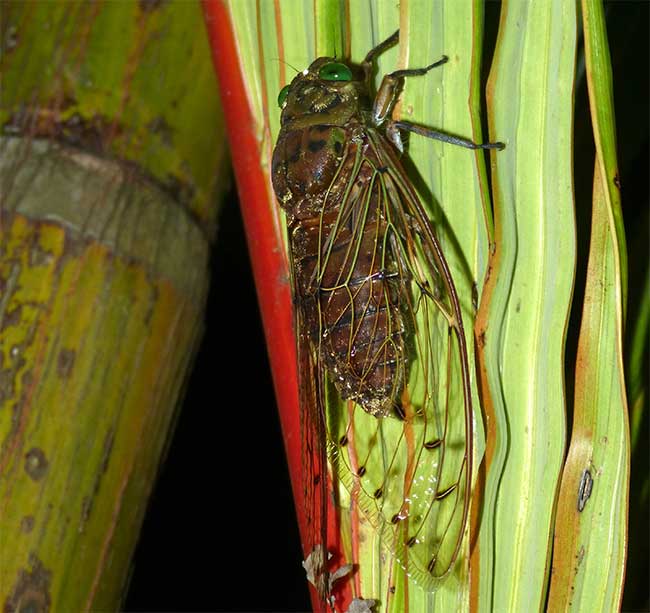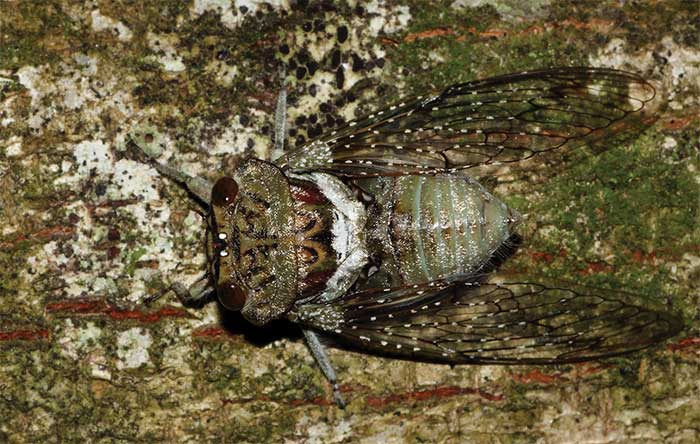Decode the 'sound' of the cicada
Compared to the small body, cicadas are really impressed by the coo. Tingling cicadas, low and low, melodious and melodious like a perfect symphony. Scientists have long wanted to answer questions about the special abilities of this creature.
Cicada (also called needle meditation) is a super family of insects with big heads, two inner wings with many veins. There are about 2,500 species of cicadas in the world, both temperate and tropical. Cicadas are the most well known insects because of their distinctive shape with a large head and the ability to make loud, loud, loud sounds throughout the summer. In the Appalachian Mountains, Americans call the cicadas dry flies because their bodies are intact and dry after molting. Cicada do not bite, do not bite and are harmless to humans. Many people eat cicadas (as in ancient Greece, China, Malaysia, Myanmar, Latin America and the Congo) and use cicadas as oriental medicine.

The Empress cicada in Southeast Asia makes the loudest sound in the world.
Cicadas take from 13 to 17 years to mature, depending on age. They also spend most of their time underground, but when they reach maturity, they emerge to the surface for a few weeks to shake off their old wings and mate, breed offspring and die. Their brief presence on the ground is marked by their seductive mating, with songs that can reach 100 decibels.
And the question is, are cicadas the loudest cries? Professor John Petti from the University of Florida decided to find out the answer to this problem. He looked at previously published studies, as well as asked entomologists he was familiar with, and received various answers, such as European mole cricket and American grasshopper . These animals can emit 96 decibels at a distance of 50cm. However, these sounds are far inferior to some cicada species.

African cicada Brevisana brevis.
According to Petti, the Tibicen walkeri cicada, one of two Walker cicadas living in North America, can produce the loudest sound of up to 108.9 decibels. At a distance of 50cm, they emit 105.9 decibels, still lower than the African cicada Brevisana brevis is 106.7 decibels. However, the loudest sound record for the Brevisana brevis was later broken by the Empress cicada in Southeast Asia.
In a study conducted in 1995, entomologists measured the loudness of dozens of cicada species. And they found that the loudness that each cicada emits is proportional to their body mass.
From there, we can perform a calculation on our own. Brevisana brevis - thought to have the loudest sound - weighs 0.3g when it dries, which is still far behind the Empress cicada of Southeast Asia with a wingspan of 18-20cm, which can weigh up to 2g. Thus, if the sound is proportional to the volume then the Empress species obviously has no rival. And maybe now people just have to wait for scientists to announce another record.
How does cicada make sounds?
A team from Naval Undersea Naval Center (NUWC) has been investigating the unique ability of the cicada to make these loud noises, which will pave the way to creating mimic devices. Underwater remote variables, communications between ships, rescue operations and other applications.
Accordingly, the scientists meticulously analyzed the physical properties of the cicada, using a laser to measure the vibrations at the so-called 'sound drum' in the insect's outer bone. The results showed that this vibration occurred extremely fast at a speed of 300 to 400 times / second, making the cicadas can emit a strong sound.
The analysis shows that, to create the vibration on because they have a unique skeleton, combined with a tendon membrane on the body , will vibrate when they deform the body.
Derke Hughes, a researcher at the NUWC Center, said to understand how cicadas make their sounds, you'll have to imagine you're maximizing your ribs, then relaxing and then repeating that action.
If humans had parts like cicadas, we could have a thick set of muscles on both sides of the ribs, allowing them to go deep into the chest, causing all ribs to be tightly pressed into one. deformed mind. When the muscles are relaxed, the ribs return to their original state and pull the muscles to repeat the cycle again. Cicadas repeat this cycle to the left and right about 300 - 400 times / second.
Male cicadas make sounds to attract females near them, females that make no sound, will respond by flapping their wings. When the males hear the flapping of their wings, they will come closer and make a softer sound when approaching the females.
- Cicada's love song entered the US Navy's sights
- Watching 'flying elephants' is extremely poisonous in Vietnam
- Implant human eyes on cicada wings
- Decode the mysterious sound of
- The scaryness of sound: saving people and destroying each other in a narrow way!
- The process of pupating molting into cicadas
- Decode the mysterious sound of the Northern Aurora
- Cicada 3301 - The most mysterious organization on the Internet
- Close-up of the cicada process
- Decode whale sounds
- Decode 13 strange sounds of the body
- Kill cicada larvae that harm coffee?
 Why do potatoes have eyes?
Why do potatoes have eyes? 'Tragedy' the world's largest carnivorous life: Death becomes ... public toilet
'Tragedy' the world's largest carnivorous life: Death becomes ... public toilet Tomatoes were once considered 'poisonous' for 200 years
Tomatoes were once considered 'poisonous' for 200 years Detecting microscopic parasites on human face
Detecting microscopic parasites on human face